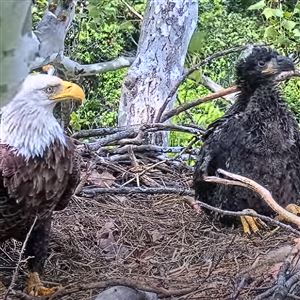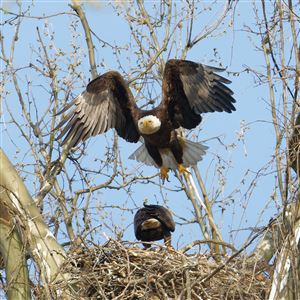The formerly endangered peregrine falcon produced a bumper crop of at least 23 juveniles this year in the Pittsburgh region.
That’s a lot of young birds that will add to an already busy landscape with more peregrine nests than volunteer monitors can confirm.
Now is when raptor juveniles take to the Pittsburgh skies to learn to fly and hunt, while continually begging their parents for food.
Sound familiar? They stop back home after they’ve left the nest, hoping to find a meal.
With high enrollments in “falcon school” this year, the young peregrines are learning to take dangling prey from their parents’ talons or beak and other feats, said Kate St. John, of Oakland, who has been monitoring the region’s peregrine falcons for the Pennsylvania Game Commission for 25 years.
She chronicles peregrines and other local wildlife in her “Outside My Window” blog.
A recent entry featured one of the young falcons, known as Yellow, returning to its home at the Cathedral of Learning at the University of Pittsburgh after leaving the nest and “crashed in on her mother,” Ms. St. John posted on June 23. The National Aviary’s FalconCam captured the moment.
There are at least seven active peregrine nests in the region including the Cathedral of Learning; East Liberty Presbyterian Church’s steeple; the Sewickley Bridge; the Westinghouse Bridge in Turtle Creek; and the Tarentum Bridge.
And there are others that watchers aren’t monitoring.
“We have a lot of peregrines but we don’t have as many observers to know if the other nests are successful or not,” she said.
There’s seems to be a nest near the Highland Park Bridge but volunteers can’t find it. Then in places where there are known nests, such as the Graff Bridge in Kittanning, there is no one in that area reporting on it.
Falcon nest monitoring, primarily done by volunteers, is no longer required since the peregrine was taken off the state endangered/threatened list in 2021.
Ms. St. John has witnessed a significant population boost from when only one pair of peregrine falcons nested in the region, with the first nest in 1991 on the Gulf Tower in Downtown Pittsburgh when the bird was still federally endangered.
Efforts by a national nonprofit, The Peregrine Fund, the state Game Commission and other agencies slowly restored peregrine populations. More than 73 pairs were nesting in the Commonwealth in 2021, according to the Game Commission.
Currently, breeding success has drawn many falcons looking for nest sites, as evidenced by the reported number of “floaters,” which Ms. St. John tracks.
Floaters, whether a peregrine falcon or a bald eagle, are young adults vying to find a territory.
Often, they show up at established nests, such as the Cathedral of Learning and the former Hays bald eagle nests, and try to usurp one of the resident birds to win coveted territory, she said.
Ms. St. John blames the continued presence of floaters at the Hays bald eagle nest as one of the factors that caused the birds to build a new nest across the Monongahela River in Glen Hazel.
After young peregrines leave the nest and can fly on their own in Oakland, they visit other buildings and perch. Their parents teach them to hunt.
The adult birds offer prey from their talons or dangling from their beak, encouraging their children to snatch it in mid-air, Ms. St. John said. Peregrines, the fastest animal on earth, attack their prey on the wing.
The mid-size raptor with long, pointed wings has been clocked at more than 200 miles per hour in a vertical dive and 60 mph for level flight, according to the Game Commission.
“It’s amazing how slowly the father [known as Ecco] will fly to teach his young, and they are screaming all the time for food,” Ms. St. John said.
After about six weeks under their parents’ tutelage, the young falcons strike out on their own. Their first year is the most dangerous with a more than 60% mortality rate, she said. Windows pose a great hazard to juveniles and all birds in urban places, she added.
The young bald eagle Ocho in the U.S. Steel Irvin Plant’s aerie in West Mifflin took his first tumble from the nest and then his first flight more than a week ago.
He still shows up on the live webcam, making pitstops at his parents’ nest along the Monongahela River.
With its four cameras, the live nest webcam system at U.S. Steel has been picking up Ocho perched along the river and the mill’s railroad tracks.
The parents continue to bring food to Ocho although he has flown from the nest, said Don German, plant manager.
A primary challenge for juvenile bald eagles is to learn to land.
“They have to figure out how to get their landing gear up for a soft landing,” Mr. German said. “After eight days since fledging, Ocho is doing great.”
The young bird lives a perilous life in and out of the nest. The male Irvin brought a fish with fishing line to the young bird this season. Luckily the male dug it out of the fish and dropped it on the side of the nest. This is the third year straight the eagle parents delivered a fish to their young ensnared in fishing line and sometimes tackle.
For the rest of the summer, the eagle family will spend more time along the river with the young eagle working on his hunting skills.
Bald eagle parents will continue to feed their newly fledged young for four to 10 weeks, according to the Game Commission.
First Published: June 29, 2025, 4:00 a.m.
Updated: June 30, 2025, 11:46 a.m.


